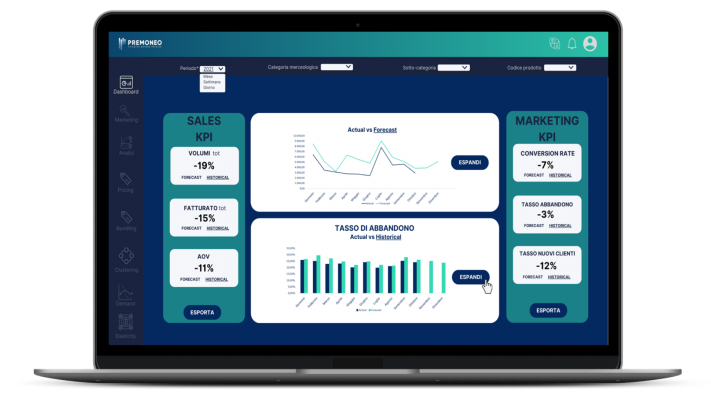In recent years, artificial intelligence and machine learning have contributed to the development of many sectors. Retail has undoubtedly benefited from this evolutionary push to the point of achieving an estimated growth in CARG of 35% between 2019 and 2024.
The first reason, and probably the most obvious one, that has favoured the implementation of AI in this sector is the ability to quickly process large amounts of data that would otherwise be unusable. In fact, through artificial intelligence it becomes possible to know market trends, elaborate asales forecastand analyse purchase behaviour in depth. It is possible to minimise user churn rates, optimise restocking and reduce overall waste. AI technologies also make it possible to predict the achievable results of a given pricing strategy.
Retail, AI and Customer Experience
Artificial intelligence also comes to the rescue of retailers in improving the consumer experience by providing constant support to customers by automating those functions that were traditionally performed by humans to improve them. Conversational chatbots, recommendation systems, proximity guidance and much more. In this way, AI makes it possible to create added value in the customer experience, lowering the cost of labour and significantly reducing the margin of error.
Besides, AI also enables the optimisation of inventory management and space utilisation. By taking into account consumer preferences, the day and time of day, and the location of products, AI-driven robots can optimise shelf position and price, with the dual consequence of increasing sales and reducing wasted space.
Artificial intelligence technologies apply to various areas of the retail industry. By harnessing the full potential of machine learning, deep learning and artificial intelligence, it is possible to effectively analyse large amounts of data, make real-time decisions, optimise the supply chain and improve the customer’s shopping experience.
Best practice in using AI and Machine Learning in Retail
Currently, many large retail companies have been able to appreciate the improved contribution of artificial intelligence, such as Amazon, eBay, Marks&Spencer and Walgreens.
For example, Amazon with its Amazon Go stores, like its competitors in Standard Cognition, has created checkout-free shops that identify in real-time the items placed in the shopping cart and charge the cost at the shop’s exit without the consumer having to go through the checkout. eBay and Marks & Spencer, on the other hand, have developed artificial intelligence algorithms that, based on the analysis of demand, seasonality, promotional activity and many other variables, can provide different pricing strategies, functional to the achievement of commercial objectives.
Or, concerning inventory management, AI has been used to create efficient restocking systems that can minimise the risk of out-of-stocks and at the same time avoid overstocking products that will not be purchased in large quantities by consumers. This is made possible through an advanced analysis of large amounts of data based on the identification of repeated patterns of behaviour. For example, in pharmaceuticals, Walgreens collects data on the number of antiviral prescriptions made to monitor flu to predict areas where flu is most prevalent and stock more antivirals in certain areas.
The benefits of AI and Machine Learning in Retail
These examples highlight the enormous possibilities that artificial intelligence offers in the retail world to address current inefficiencies and optimise future outcomes.
In any environment where companies have large amounts of sales and consumer data, the use of Clustering, Machine Learning and Forecasting algorithms can increase the competitiveness of operations, identify hidden business opportunities and reduce the likelihood of human error.
This does not mean that Artificial Intelligence will replace human activity, but rather that it will allow resources to be allocated to more strategically relevant roles, leaving the more schematic tasks to machines.



